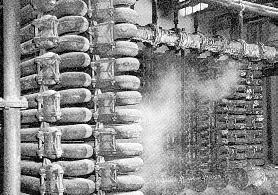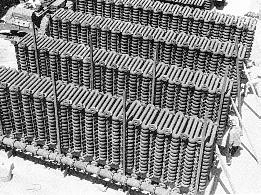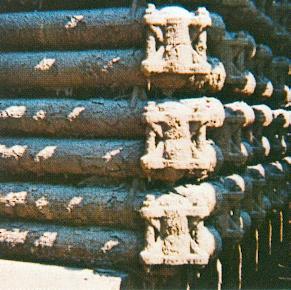|
||
| Sulphuric Acid on the WebTM | Technical Manual | DKL Engineering, Inc. |
Knowledge for the
Sulphuric Acid Industry
![]()
Sulphuric Acid on the Web
Introduction
General
Equipment Suppliers
Contractor
Instrumentation
Industry News
Maintenance
Acid
Traders
Organizations
Fabricators
Conferences
Used
Plants
Intellectual
Propoerty
Acid
Plant Database
Market
Information
Library
Technical Manual
Introduction
General
Definitions
Instrumentation
Plant Safety
Metallurgial
Processes
Metallurgical
Sulphur Burning
Acid Regeneration
Lead Chamber
Technology
Gas Cleaning
Contact
Strong Acid
Acid Storage
Loading/Unloading
Transportation
Sulphur
Systems
Liquid SO2
Boiler Feed Water
Steam Systems
Cooling Water
Effluent Treatment
Utilities
Construction
Maintenance
Inspection
Analytical Procedures
Materials of Construction
Corrosion
Properties
Vendor Data
DKL Engineering, Inc.
Handbook of Sulphuric Acid Manufacturing
Order
Form
Preface
Contents
Feedback
Sulphuric Acid
Decolourization
Order Form
Preface
Table of Contents
Process Engineering Data Sheets - PEDS
Order
Form
Table of Contents
Introduction
Bibliography of Sulphuric Acid Technology
Order Form
Preface
Contents
Strong Acid System - Acid Cooling
June 22, 2003
| Introduction | Associated
Links
Anodic Protection |

 The
absorption of water and sulphur trioxide into sulphuric acid is an exothemic
reaction resulting in an increase in the acid temperature as it exits the tower.
This heat must be removed before the acid is returned to the tower.
The function of the acid cooler is remove this heat from the acid stream and to
reject it to the environment or recover the heat as useful energy.
The
absorption of water and sulphur trioxide into sulphuric acid is an exothemic
reaction resulting in an increase in the acid temperature as it exits the tower.
This heat must be removed before the acid is returned to the tower.
The function of the acid cooler is remove this heat from the acid stream and to
reject it to the environment or recover the heat as useful energy.
In early acid plant designs this energy was considered low grade heat and the energy was simply rejected to the environment usually via a cooling water system. Early acid cooling systems consisted of cast iron 'serpentine' coolers, so-called because of their shape. They were generally cooled with cooling water being sprayed on the outside with the acid flowing on the inside.
 These
coolers had several disadvantages, such as:
These
coolers had several disadvantages, such as:
Some cast iron cooler installations still exist in a few acid plants.
In the mid 1960's CIL (Canada) began the search for a better alternative. After many years of development work and testing, the anodically protected shell and tube stainless steel acid cooler was introduced to the industry. The shell and tube units were more compact than the cast iron coolers and the all welded construction virtually eliminated the potential for leaks. The key to the success of the shell and tube acid cooler is the use of anodic protection.
Anodically
protected stainless steel air-cooled heat exchangers were also designed and
built but were of limited success. Anodic protection allowed higher
operating temperatures of 120°C (250°F) instead of the lower 85°C (185°F)
maximum temperature of conventional air coolers. The higher operating
temperatures resulted in smaller surface areas, reduction in the number of fans,
lower operating horsepower and higher operating efficiencies. The problem
with the design is the difficulty in anodically protecting the tube side of a
heat exchanger. For the system to protect the material the current must be
able to reach down the entire length of the tubes and this is very difficult to
achieve on the tube side of an exchanger.
Plate heat exchangers are a popular alternative to shell and tube acid coolers because of their compact size and lower costs. They offer very high heat transfer coefficients compares to shell and tube acid coolers. Materials of construction such as alloy C-276 allow the units to operate without anodic protection. The price advantage is still maintained even though more corrosion resistant and expensive materials are used compared to 316L SS because the plates are very thin. Anodic protection of plate heat exchanger using 316L SS plates was attempted but ran into the same problems as the attempt to commercialize anodically protected air coolers. Alloy C-276 plate heat exchangers were limited to a maximum inlet temperatues of 90°C (194°F) for corrosion reasons. The introduction of Hastelly D-205 and Cronifer 2803 Mo as a plate material allows acid temperatures to go beyond the 90°C (194°F) restriction.
Spiral heat exchangers are another option for acid cooling. They offer many of the same advantages as plate heat exchangers.
A seldom used cooling option are PTFE tank coils. There unique design do not lend itself to the typical acid plant and are used in special cases where other exchangers are not suitable.
A fairly recent advancement are shell and tube coolers constructed entirely of high silicon stainless steels such as Sandvik SX. Using this material eliminates the need for anodic protection. Acid is no longer restricted to the shell side of the exchanger as is the requirement for anodically protected acid coolers.